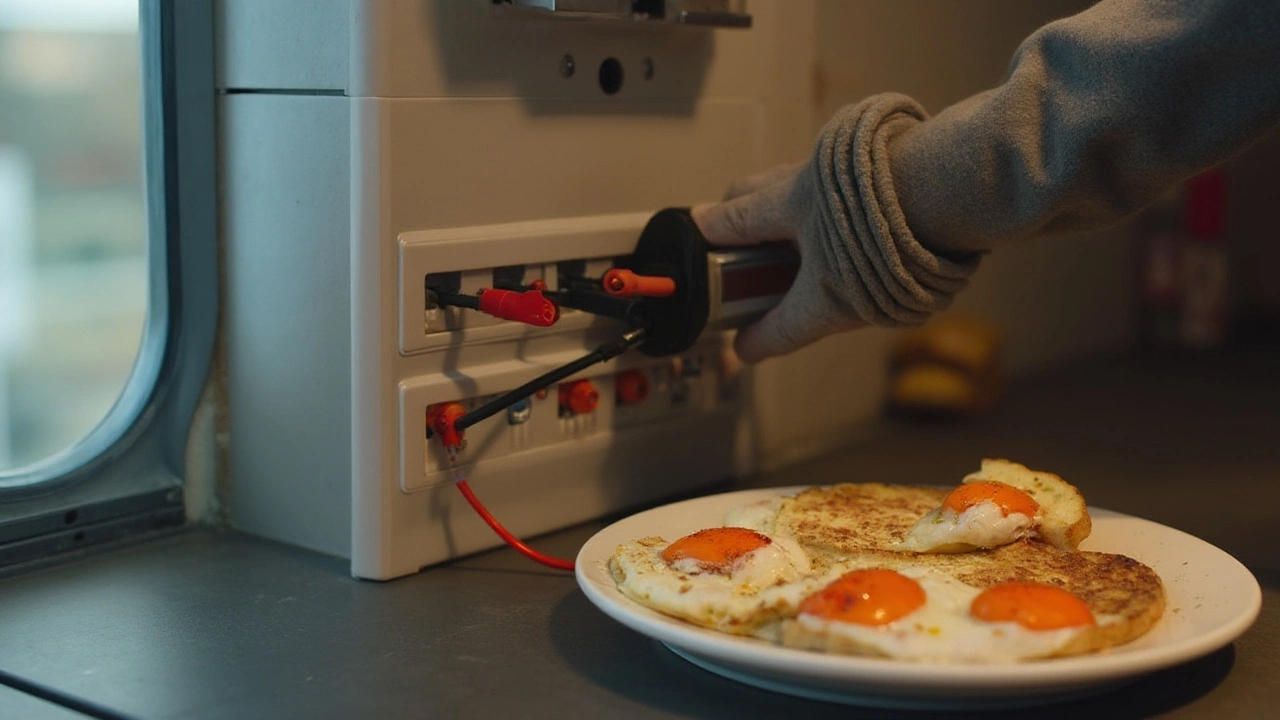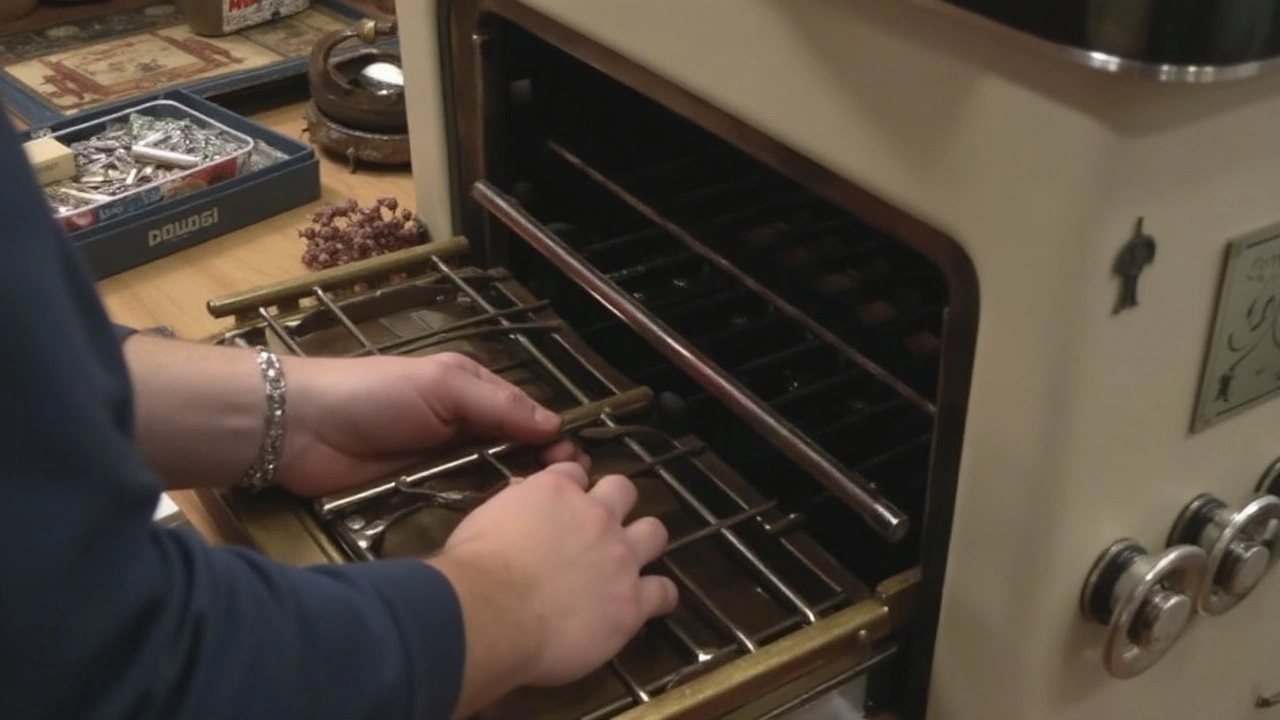When your electric oven stops producing heat, it can feel like a culinary crisis. But before you rush out to buy a new one or call in a professional, it's worth taking a moment to understand what might be going on.
Sometimes, the cause of the problem is surprisingly simple, and you could find the solution right at your fingertips.
In this article, we will take a deeper look into the possible reasons behind an oven's refusal to heat up. We'll explore practical steps for diagnosis and offer tips that could save both your meal and your money.
By the end, you might just be the unsung hero saving dinner in the nick of time.
- Power Supply Issues
- Broken Heating Elements
- Thermostat Malfunctions
- Faulty Oven Control Boards
- Safety Tips and Precautions
- When to Call a Professional
Power Supply Issues
Without a reliable power supply, your oven is just a shiny box with potential. The very first step in troubleshooting your electric oven’s lack of heat should be to make sure it is receiving power properly. This might sound too simple, but it's surprising how often a power issue is behind an oven's failure to heat. Start by checking if your oven is plugged in correctly and the plug isn’t loosely situated in the outlet. An electric oven typically requires a 240-volt outlet, which is specifically designed to handle its wattage needs. If the plug is secure and it still isn't working, consider testing the outlet with another appliance to see if it’s functioning correctly.
Another crucial aspect is the circuit breaker. Sometimes, the circuit breaker can trip due to overloads, especially when multiple high-energy appliances run simultaneously. Head to your home’s electrical panel and see if the breaker for the oven is in the ‘off’ position. If it is, a simple flip can restore power to the oven. However, if the breaker consistently trips after being reset, that's a sign of a more serious wiring or electrical issue that will need professional attention.
There’s also the possibility of a blown fuse within the oven itself. Most modern electric ovens have internal fuses designed to prevent major electrical problems. If the fuse is blown, the oven might not heat at all. You can usually locate these fuses in the back of the oven or behind the back panel. Check your owner’s manual for the exact location. It’s important to replace any blown fuses with the same type and rating to prevent any safety hazards.
“I always tell customers when dealing with appliances, understanding the power setup is half the battle,” remarked John Matthews, a senior technician at Appliance Tech Solutions.
A more technical investigation involves evaluating the power cord itself. Power cords can degrade over time and lead to interruptions in the power flow. Examine the entire cord for any visible signs of wear, scorch marks, or loose connections. If you notice any of these, it’s best to replace the cord completely. Remember, working with appliances and electricity can be dangerous, so exercise caution and prioritize safety.
If you have a power consumption meter, it might come handy at this stage. You can plug the meter into the outlet and then plug your appliance into the meter. This will give you measurements of how much electricity is being drawn when the oven is turned on. Such readings can pinpoint issues in how your oven is consuming power, although they require a bit of technical knowledge to interpret correctly. Don't hesitate to look for professional help if these checks do not resolve your problem.
Broken Heating Elements
When your trusty electric oven decides to stop heating, often the culprit is a broken heating element. The heating elements inside your oven are basically coils made to conduct electricity and generate heat, kind of like the glowing stars of your kitchen. But after years of loyal service, these coils can wear out, bend, or even break. A visual inspection can provide telltale signs — look out for burns, breaks, or blisters along the coil. If any of these signs are present, it’s time to consider a replacement.
Once identified, reaching the heart of the matter is not as daunting as you might think. First, ensure your oven is unplugged to prevent any electrical mishaps. Unscrew the elements from the oven’s back wall with a firm but gentle grasp, taking care to remove the wires that connect invisibly but powerfully at the rear. Replacement elements are relatively inexpensive and widely available, making this a repair quick enough to restore your culinary escapades without delay. To make sure everything is sorted right from the start, a multimeter can be used to test the element's continuity—this checks if there’s a complete electrical circuit. If the multimeter doesn’t show a reading, it indicates a break inside the element, confirming it needs replacement.
"Your oven relies on the heating element for its primary function, and even a small break can render it useless," notes appliance expert Jennifer Rogers, echoing the experiences shared by many. "Ensuring a proper fit when replacing is integral for optimal performance and safety."
Consider taking photographs or making notes on the bevy of wires before you attempt disassembly—it’s a tip from seasoned repair aficionados that could prevent unnecessary headaches. In case a replacement seems daunting, don't hesitate to reach out to tech support or local repair shops for guidance. Following installation, conduct a test-run by setting the oven to a low temperature and observe whether the element glows evenly once more. Effective electric oven repair could just be around the corner with this insightful fix.
Be forewarned, if complications persist post-replacement, it might hint at underlying issues like thermostat challenges or deeper electrical troubles. This could be an avenue to connect with a professional technician who delves deeper into the appliance's workings. Repairing a oven not heating may seem like a laborious task, but the rewards of your favorite dishes baking perfectly are worth the effort. Reuniting with the warmth of an operable oven could be as satisfying as the aroma of fresh bread wafting through your home.

Thermostat Malfunctions
The thermostat is the heart of your electric oven's operation, responsible for regulating the temperature and ensuring that your culinary creations bake evenly and correctly. When the thermostat malfunctions, you might find your oven refusing to heat up properly—or even worse, overheating to the point where your chocolate chip cookies become charcoal chip catastrophes. A common symptom of a thermostat issue is the oven not reaching the desired temperature, which can be particularly frustrating when you're trying to bake a delicate soufflé. It's important to recognize the signs early, as a defective thermostat not only disrupts cooking but can also lead to wasted time and energy costs.
When you suspect the thermostat might be to blame, a basic understanding of its functionality can be helpful. Typically, an oven thermostat senses the temperature inside the oven cavity, communicating this information back to the control board to adjust the heat as needed. If this communication fails, your oven may not heat at all. Oftentimes, a simple calibration could set things right, but in some cases, physical damage to the sensor or the wiring could be the real culprit. Catching these issues early could save a lot of headaches and perhaps even avoid costly repairs.
Checking Your Oven's Thermostat
Before you embark on any repairs, safety comes first. Ensure your oven is unplugged, cutting off any electrical supply to avoid shocks. Once that's out of the way, checking the thermostat can be relatively straightforward. Refer to your oven's manual to locate the thermostat, usually found at the back of the main oven cavity. Carefully inspect it for any signs of wear, burning, or disconnection. Loose or corroded wires might also cause unreliable temperature readings. A multimeter can be handy here to test the continuity of your thermostat. Remember, if the thermostat isn't exhibiting the correct electrical flow, it's probably time for a replacement.
"A well-regulated thermostat ensures even baking and prevents overheating, saving both energy and your culinary creations," notes appliance expert Sarah Mulligan in her book on home troubleshooting.
If you're unsure about fiddling with electrical components, consulting a professional is never a bad idea. They can provide a definitive answer with accurate diagnostics and often have the tools and parts needed for a seamless fix. In many cases, if your thermostat is consistently problematic, replacing it might be more cost-effective than repeated repairs, ensuring your oven functions reliably for many meals to come.
Comparing Costs and Options
When faced with a potentially faulty thermostat, you'll naturally consider the cost implications. On average, replacing an oven thermostat can range from $100 to $300, depending on the make and model. This might seem daunting initially, but when compared to the cost of a new oven, diligent repair becomes an attractive option. Plus, it's a greener choice by increasing the lifespan of your existing appliance. It's also worth noting that in many cases, ovens under warranty might cover thermostat replacements, so always check your warranty documents before proceeding with out-of-pocket expenses.
| Brand | Average Thermostat Replacement Cost |
|---|---|
| Whirlpool | $120 |
| GE | $150 |
| Samsung | $200 |
Paying attention to the signs a thermostat is giving might save you from a kitchen nightmare. Whether it's calibrating, replacement, or simply keeping an eye on its performance—understanding this small but vital component is pivotal to keeping your electric oven repair operations in check.
Faulty Oven Control Boards
If you find yourself frustrated by an electric oven that's refusing to heat up, your attention might need to shift toward a less obvious villain: the control board. The oven control board acts as the brain of your appliance, regulating the various functions and ensuring your oven responds accurately to your temperature preferences. When this crucial component fails, the oven might not recognize the heat settings, or it might not supply power to the heating elements. This issue can stem from anything – from worn-out components to electrical surges causing havoc in the circuitry.
In the event of a malfunctioning control board, what seems like a major problem often has surprisingly straightforward indicators. You might notice that the display panel is blank, showing error codes, or behaving erratically with an unresponsive touchpad. These signs often lead homeowners down the path of troubleshooting, hoping to pinpoint the root cause. Engaging with a faulty control board can be daunting, though, given its complexity, but identifying symptoms can be the first step toward resolution.
Identifying Issues with Control Boards
Embarking on an investigation of your oven’s inner workings doesn’t necessitate an engineering degree, though it does require a methodical approach. Begin by ensuring the appliance is disconnected from any power source to avoid electric shock. Once secure, remove the back panel of the oven with a screwdriver, revealing the control board. Inspect the board for visible signs of damage such as burnt components or moisture exposure. Sometimes, these boards exhibit burned out spots or blown fuses which indicate the source of the problem. In fact, an article in Repair Clinic notes, "Most control board failures in ovens usually arise due to power surges or excessive heat exposure," highlighting the typical origins of the issue.
While inspecting the board, consider consulting the oven’s manual to better understand what each component should look like and function. This guidance can be invaluable as you attempt to differentiate between normal wear and technical faults. If the board looks intact but the problem persists, measuring the output with a multimeter might reveal if electrical flow is consistent. An inconsistent or absent flow suggests it's time for a replacement.
Replacing vs Repairing the Control Board
Once you’ve identified that the control board is faulty, you face the decision of whether to repair or replace. Replacing an oven control board can sometimes be the most straightforward solution, as it eliminates the guesswork of tracking intermittent faults. New boards can be purchased online, using the model number of your oven to match compatibility. However, it's essential to consider whether the cost involved aligns with your appliance's age and value. You may feel torn between sticking to a device that has served you faithfully or investing in a new one that might be more energy-efficient.
Repair, on the other hand, is often suitable for minor issues like replacing a fuse or soldering a loose connection, tasks generally reserved for individuals comfortable with handling electronics. It's worth noting that sometimes, repairs can provide a temporary fix, as the residual damage is enough to cause future malfunctions. When opting for repair, carefully assess skills and tools required, ensuring safety remains paramount.
Armed with knowledge and the right approach, homeowners can often tackle an oven not heating due to a faulty control board. Not only can this endeavor save time and money, but it can also extend the lifespan of an appliance that serves as the heart of many kitchens. As always, exercise caution during any DIY repairs and don't hesitate to seek professional assistance if the task seems daunting.

Safety Tips and Precautions
While diving into electric oven repair can be a rewarding venture, it's crucial to prioritize safety before anything else. Mistakes in handling electrical appliances can lead not only to malfunction but also to severe injuries. The very first step is to disconnect the power supply. Don't rely on just switching off the oven. Pull the plug from the socket or turn off the circuit breaker. This is your primary shield against electric shocks.
Ensure your working area is clear and well-lit to avoid accidents. Darkness or clutter can easily lead to mishaps, especially when handling tools or parts. Wearing rubber-soled shoes can offer additional insulation from electric current, which is never a bad idea. A recent study found that improper footwear is responsible for a notable number of electrical-related injuries during DIY tasks.
According to the Electrical Safety Foundation International, "Working on appliances can be safe if approached properly. Ensuring a powered-down environment reduces risks substantially."
Approaching the appliance, using the correct tools is just as crucial. Avoid using tools not meant for electrical repairs, as they can damage parts further or pose a risk to safety. Insulated screwdrivers and pliers are often recommended for tackling electrical elements. Remember, this isn't just about fixing the oven but doing it without risking injury.
Before you start taking things apart, familiarize yourself with the user manual or any repair documentation available. Most manufacturers provide detailed instructions or schematics showing the layout and parts of your oven. This prevents unnecessary dismantling and helps you identify the root cause efficiently. If unsure, there’s no harm in seeking information online or from oven repair communities or forums.
Another safety concern is handling the oven's heating elements. These parts, even when not in use, can hold residual heat. Wait sufficient time after usage before touching them. Use heat-resistant gloves as an extra layer of safety. Keep in mind that any repair that involves wiring or intricate electrical setups should be approached with the utmost caution. Even a seemingly small oversight can have significant repercussions.
Last but not least, understand your limits. If diagnostics or repairs start feeling overwhelming, or if a problem seems beyond a simple fix, it's wise to call in a professional. Professional repair services not only guarantee your oven will work correctly again, but they also ensure every step adheres to safety standards. DIY repairs are satisfying, but there's no shame in asking for assistance when safety is on the line.
When to Call a Professional
You've poked around, given the oven a few tinkers of your own, and yet, there's still no sign of heat. Sometimes, the best decision you can make with a misbehaving electric oven is to step back and call in the cavalry, aka the professionals. But knowing exactly when to make that call can save you unnecessary frustration and expenses. Often, the tell-tale signs that it's time to dial up an expert involve complexities that go beyond a quick fix or a simple household tool.
Firstly, if you've noticed a persistent burning smell without having dinner to blame for it, that's a clear indicator. This could mean the wiring or internal components have gone awry—a job meant for those with the right knowledge and tools. Likewise, if the oven's display panel is blank, acting erratically, or has blinking error codes, a technician will be better equipped to decode and fix these issues without risking further damage.
According to the U.S. Fire Administration, electrical malfunctions account for over 11% of residential fires annually. Professional intervention can help minimize these risks significantly.
Another situation that warrants professional attention is when there's a physical obstruction preventing the oven door from sealing properly, or if you've spotted visible damage to critical parts, like a charred element or cracked interior lining. Attempting DIY repairs in such scenarios can turn a small problem into a more costly one, not to mention the safety hazards involved.
Moreover, if you've attempted to use a multimeter to check the continuity of heating elements, and the readings baffle more than illuminate, a repair specialist can provide a clearer diagnosis. While it might seem trivial, the calibration of an oven's thermostat is an intricate affair, involving specialized knowledge that guarantees your meals won't end up charred or undercooked. A certified technician uses tools specifically designed for this purpose, ensuring precision far beyond a personal guesswork.
Finally, those confusing code malfunctions can often be solved more easily by seasoned professionals who are familiar with your oven's specific brand and model. They can ensure a part replacement is done correctly and efficiently, confirming that your oven repair is not only temporary but long-lasting. For peace of mind and the health of your kitchen appliance, knowing when to call a professional is just as important as knowing how to tackle small fixes.

